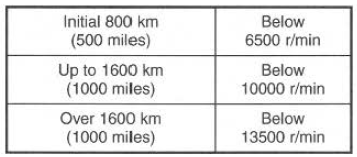Suzuki GSX-R 1000 Owners Manual: Break-in
The first 800 km (500 miles) is the most important in the life of your motorcycle. Proper operation during this break-in period will help assure maximum life and performance from your new motorcycle.
The following guidelines explain proper break-in procedures.
Maximum engine speed recommendation
The table below shows the maximum engine speed recommendation during the break-in period.

Vary the engine speed
Vary the engine speed during the break-in period. This allows the parts to "load" (aiding the mating process) and then "unload" (allowing the parts to cool).
Although it is essential to place some stress on the engine components during break-in, you must be careful not to load the engine too much.
Breaking in the new tires
New tires need proper break-in to assure maximum performance, just as the engine does. Wear-in the tread surface by gradually increasing your cornering lean angles over the first 160 km (1 00 miles) before attempting maximum performance. Avoid hard acceleration, hard cornering, and hard braking for the first 160 km (1 00 miles).
 Warning Warning
Use extra care when riding on new tires. Perform proper break-in of the tires as described in this section and avoid hard acceleration, hard cornering, and hard braking for the first 160 km (100 miles). |
Allow the engine oil to circulate before riding
Allow enough idling time after warm or cold engine start up before revving the engine or placing the transmission in gear. This allows time for the lubricating oil to reach all critical engine components.
Observe your initial and most critical service
The initial service (break-in maintenance) is the most important service your motorcycle will receive. During break-in operation, all of the engine components will have mated together and seated. Maintenance required as part of the initial service includes correction of all adjustments, tightening of all fasteners and replacement of dirty oil. Timely performance of this service will help make sure you get the best service life and performance from the engine.
 Inspection before riding
Inspection before riding
Warning
Failure to inspect and maintain
your motorcycle properly
increases the chance of an
accident or equipment damage.
Always perform a pre-ride
inspection before each ride ...
Other materials:
Rear suspension assembly construction
Rear shock absorber mounting bolt (upper)
Rear shock absorber mounting nut (lower)
Cushion rod mounting nut (front)
Cushion rod mounting nut (rear)
Cushion lever mounting nut
Swingarm pivot nut
Swingarm pivot boss nut
Swingarm pivot shaft
Swingarm ...
Evaporative emission control system
diagram (only for e-33)
Fuel tank
Fuel-vapor separator
Fuel pump
Fuel feed hose
Fuel shut-off valve
Iap sensor
Surge hose
Evap canister
Purge hose
Evap system purge control solenoid valve
Fue
Hc vapor
Fresh air
Vacuum
...
Show data when trouble (displaying data at
the time of DTC)
Use of sds
Ecm stores the engine and driving conditions (in the form of data as shown in
the figure) at the moment of the
detection of a malfunction in its memory. This data is called “show data when
trouble”.
Therefore, it is possible to know engine and driving conditions (e.G., Whether
...

